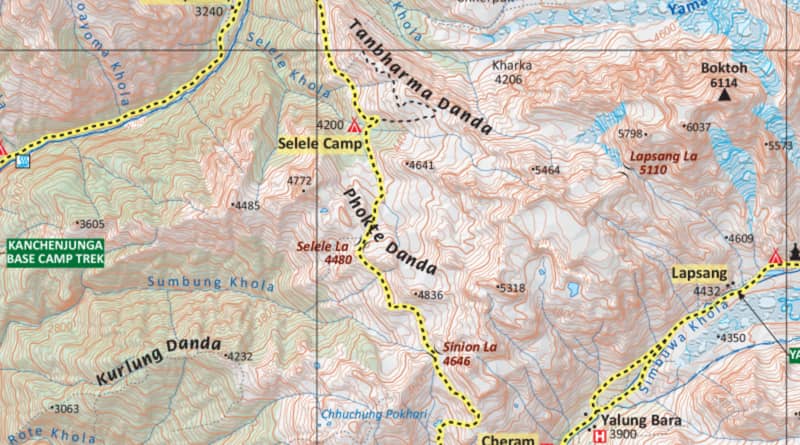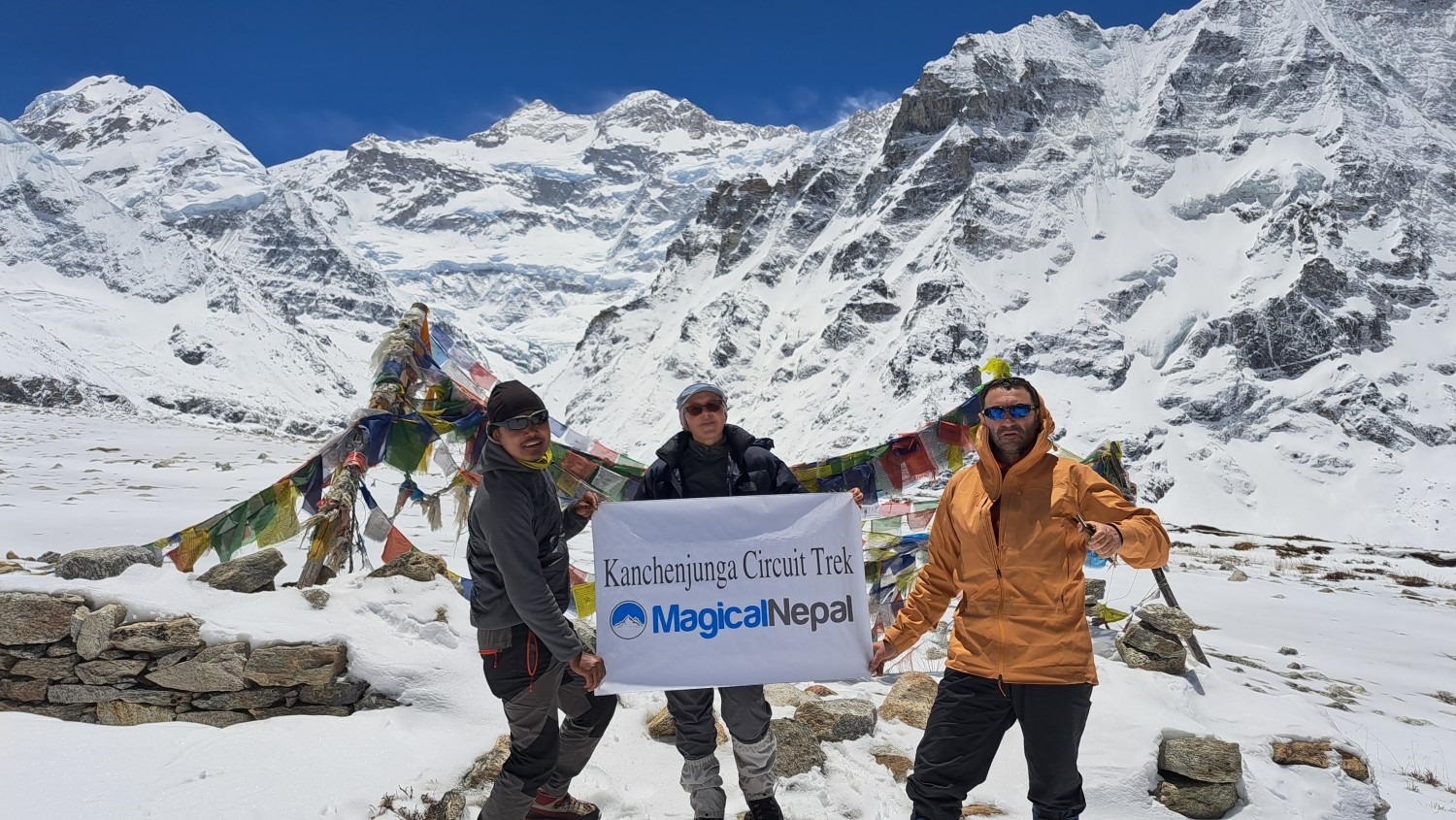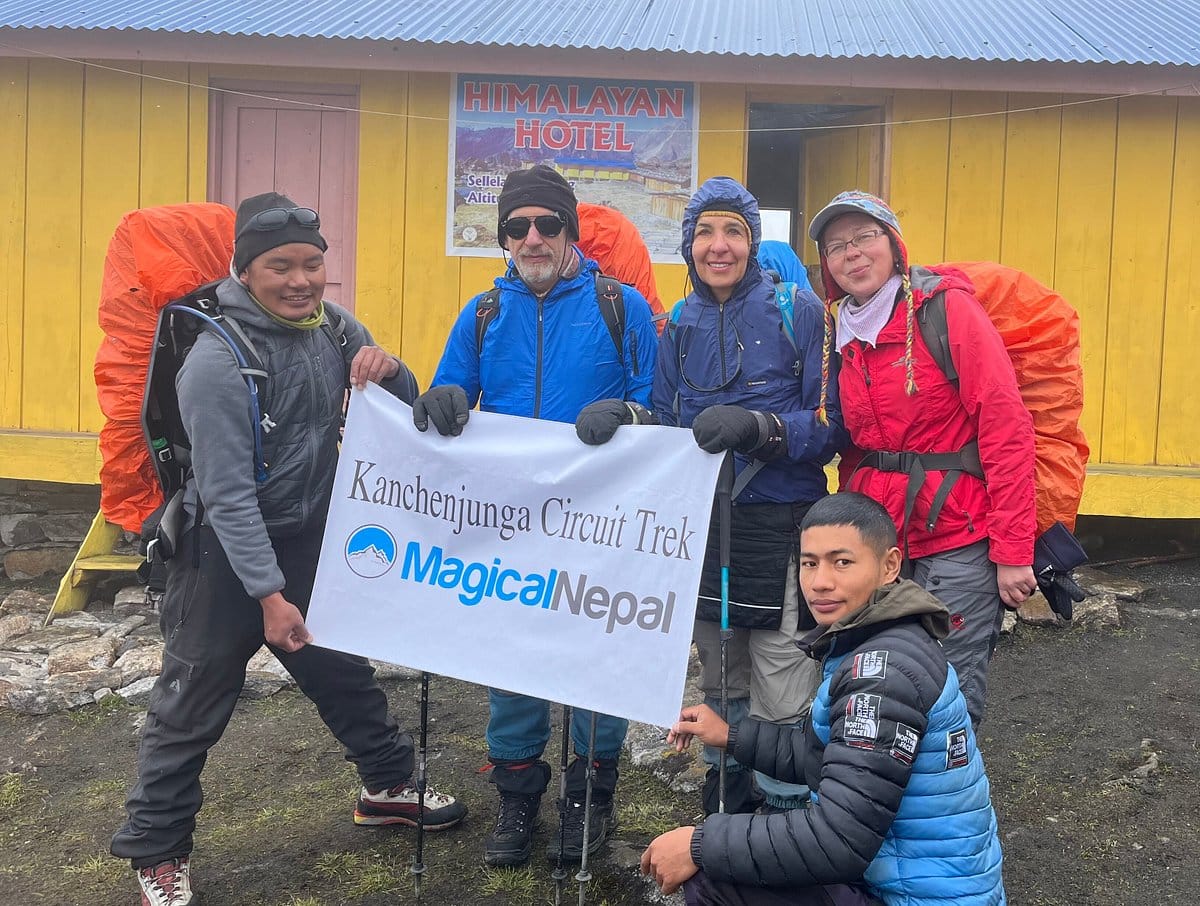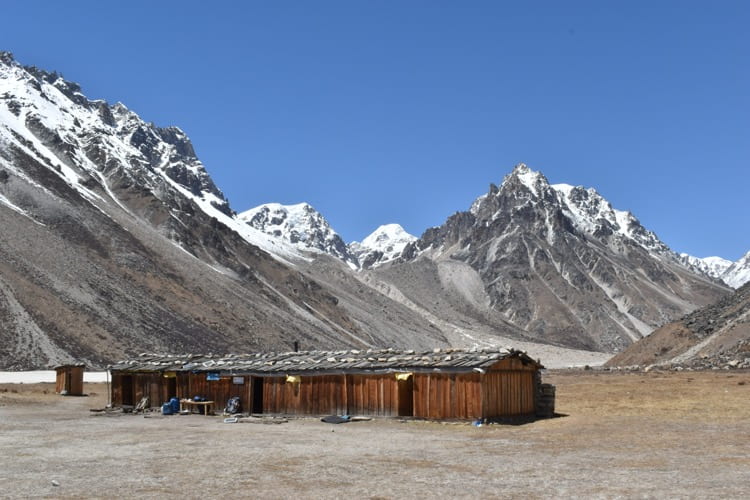Kanchenjunga Circuit Trek
- Satisfied Client
- Personalised Guide
- Instant Response
Get Instant Response:
+977-9851329446 (Whatsapp)
| Starts at: Taplejung | Ends at: Khamdime |
| Trek Region: Kanchenjunga | Transport: Flight |
| Duration: 22 Days | Trip Grade: Challenging |
| Max Altitude: 5143 m / 16873 ft (Pangpema) | Accommodation: Basic Tea House |
Kanchenjunga Circuit Trek Highlights
- Explore the less traversed Eastern mountainous regions of Nepal
- Walk past the popular glacial lakes in the region
- Amazing time walking through the diverse flora and fauna
- Meditate in Ramtang and Oktang Monasteries after your tiring walks
- Have an amazing time on the lap of the giant peaks
The Kanchenjunga Circuit trek visits both the north and south base camps of Kanchenjunga, the third highest mountain in the world at 8,586m.
Due to the fact this is a remote area trek, a good level of fitness and some trekking experience is desirable. Yet despite of its remoteness, trekkers gain insight into peoples’ way of life and can visit Ramtang and Oktang Monasteries.
On the way, the landscape is filled with rivers; waterfalls; green meadows; rhododendron, birch and pine forests; the Yalung Glacier, and of course, visitors are accompanied on the route by the majestic mountains.
Kanchenjunga itself lies on the far eastern side of Nepal, near the border with Sikkim, a tiny Himalayan state in the north-eastern part of India. Until mid-1800, it was thought Kanchenjunga was the highest peak in the world.
This area was closed to trekkers until the mid-1980. Today the region is protected by the Kanchenjunga Conservation Area and a special trekking permit is required. With these restrictions, the beautiful and unique flora and fauna of this area is still in pristine condition today.
With regards to the mountains themselves, in addition to the main peak of Kanchenjunga, there are four subsidiary summits exceeding 8,000m, the most important being Kanchenjunga West, also known as Yalung Kang (8,505m). Also found in this area are approximately twenty peaks exceeding 7,000m, the highest being Kambachen (7,903m), Janu (7,710m), Jongsong (7,483m), Kabru (7,353m), Tent Peak (7,365m) and the Twins (7,350m).
In addition, there are numerous peaks over 6,000m. Amongst this impressive cluster of peaks are five major glacial systems. Of these, Zumu, Talung and Rathong flow into Sikkim while to the west, the Kanchenjunga and Yalung glaciers flow into the mighty Tamor River of Nepal.
This just adds to the fact trekking in Kanchenjunga is an unforgettable experience where trekkers get right into the heart of the remote, less trekked, Himalaya mountains and valleys.
With the recent addition to the trekking map of the Great Himalayan Trail, tourism is being promoted in this, as well as other, remote areas so there is the opening up of more teahouses on the route. While this is positive for the local communities, now would be a good time to go to Kanchenjunga before more trekkers ‘discover’ the area!
Kanchenjunga Circuit Trek Outline Itinerary
Day 1: Kathmandu to Bhadrapur (Flight) to Ilam (Drive)
Ilam – 1677 m / 5501 ft – 5 hrs
Day 2: Ilam to Taplejung (Drive)
Taplejung – 1820 m / 5971 ft – 5 hrs
Day 3: Taplejung to Chirwa
Chirwa – 1270 m / 4166 ft – 6 hrs
Day 4: Chirwa to Lelep
Lelep – 1860 m / 6102 ft – 7 hrs
Day 5: Lelep to Amjilosa
Amjilosa – 2510 m / 8234 ft – 5 hrs
Day 6: Amjilosa to Gyabla
Gyabla – 2730 m / 8956 ft – 4 hrs
Day 7: Gyabla to Ghunsa
Ghunsa – 3595 m / 11794 ft – 4 hrs
Day 8: Acclimatization Day
Ghunsa – 3595 m / 11794 ft – 4 hrs
Day 9: Ghunsa to Kambachen
Kambachen – 4100 m / 13451 ft – 4 hrs
Day 10: Acclimatization Day
Kambachen – 4100 m / 13451 ft – 4 hrs
Day 11: Kambachen to Lhonak
Lhonak – 4785 m / 15698 ft – 4 hrs
Day 12: Day Trip to Kanchenjunga North Base Camp
Lhonak – 4785 m / 15698 ft – 8 hrs
Day 13: Lhonak to Ghunsa
Ghunsa – 3595 m / 11794 ft – 7 hrs
Day 14: Ghunsa to Sele Le
Sele Le – 4390 m / 14402 ft – 5 hrs
Day 15: Sele Le to Cheram
Cheram – 3870 m / 12696 ft – 8 hrs
Day 16: Day Trip to Kanchenjunga South Base Camp
Cheram – 3870 m / 12696 ft – 6 hrs
Day 17: Cheram to Torongding
Torongding – 2080 m / 6824 ft – 4 hrs
Day 18: Torongding to Yamphuding
Yamphuding – 1980 m / 6496 ft – 8 hrs
Day 19: Yamphuding to Khebang
Khebang – 1910 m / 6266 ft – 4 hrs
Day 20: Khebang to Khamdime
Khamdime – 1500 m / 4921 ft – 4 hrs
Day 21: Khamdime to Bhadrapur (Drive)
Bhadrapur – 93 m / 305 ft – 10 hrs
Day 22: Bhadrapur to Kathmandu (Flight)
Kathmandu – 1300 m / 4265 ft – 50 minutes
Day 1: Kathmandu to Bhadrapur (Flight) to Ilam (Drive)
- Drive time: 5 to 6 hours
- Accommodation: Hotel
After breakfast, our guide will collect you from your hotel and accompany you to the airport. The short flight to Bhadrapur takes us over the Kathmandu Valley and surrounding hill and through some of the mountains Nepal is famous for. A free mountain flight! On arrival in Bhadrapur, we will drive to Ilam, the heart of the tea plantation area of the country.
Day 2: Ilam to Taplejung (Drive)
- Trek time: 4 to 5 hours
- Accommodation: Hotel
After breakfast, we drive for 4 hours through terraced fields and hills to reach Taplejung where we spend the night. There will be time to explore the town after lunch. It is an interesting place with many Buddhist gompas.
At one of these gompas, we can see butter lamps which have been burning continuously for 400 years. A stream outside the gompa turns prayer wheels which send the mantra “om mane padme hum” to the heavens.
Day 3: Taplejung to Chirwa
- Trek time: 5 to 6 hours
- Accommodation: Tea House
Today we start our trek proper! It’s a long day of mainly downhill but we have a chance to catch our breath at the village of Sinwa on the banks of the Tamor River before continuing on.
Day 4: Chirwa to Lelep
- Trek time: 6 to 7 hours
- Accommodation: Tea House
This is another long day of 7 hours hiking. But as we pass through Tapethok we enter the Kanchenjunga Conservation Area. Here we have our permits checked before heading across a suspension bridge and ascending to Lelep.
Day 5: Lelep to Amjilosa
- Trek time: 5 hours
- Accommodation: Tea House
Waterfalls and suspension bridges are part of today’s trail. Plus we come to the first Sherpa village on our trek where we stay overnight. The village of Amjilosa is mainly used during the time when the yaks and sheep are in the pastures so very few families live here full time.
Day 6: Amjilosa to Gyabla
- Trek time: 3 to 4 hours
- Accommodation: Tea House
After breakfast, we head off through different forests of pine, bamboo, rhododendron and oak. We notice the villages and people are becoming more Tibetan like.
We also see yaks, sheep and goats on the trail, not to mention a good variety of birdlife. After lunch the trail takes us up through dense forest cover and over a wooden bridge on to Gyabla where we spend the night.
Day 7: Gyabla to Ghunsa
- Trek time: 3 to 4 hours
- Accommodation: Tea House
Today the trail continues on through forests and passed Phale Village which was a Tibetan refugee camp started decades ago when Tibetans started fleeing from the communist regime in China.
Today it is a winter settlement village. We have time to visit the village where there are some handicrafts for sale. We head to Ghunsa, the largest village in the area and one with a police station, health post and a Kanchenjunga Conservation Office. Telephone and internet services are available here.
Day 8: Acclimatization Day
- Trek time: 4 hours
- Accommodation: Tea House
We are now at higher altitude and aiming to go higher! So we take the opportunity to relax and acclimatize in Ghunsa. There is a monastery to explore and a ridge to climb.
From the ridge there are views of Jannu Peak which is worth the 5 hours plus round trip. Should you wish to climb up the ridge – and we recommend this as it helps acclimatize our bodies – we will take a packed lunch with us.
Day 9: Ghunsa to Kambachen
- Trek time: 3 to 4 hours
- Accommodation: Tea House
Views of the Jannu Himal dominate the skyline today. Following a gentle upwards path we come to a green glacier valley. Here we may be lucky to spot blue sheep and snow leopards. The trail continues on past a waterfall to a landslide-prone area where we take particular care.
Day 10: Acclimatization Day
- Trek time: 2 hours
- Accommodation: Tea House
Again we take the chance to acclimatize our bodies to the altitude and in preparation for our visit to the North Base Camp. We can climb another ridge today where we get stunning views of Kanchenjunga.
Day 11: Kambachen to Lhonak
- Trek time: 3 to 4 hours
- Accommodation: Tea House
Today the trail takes us mainly over moraine from the Kanchenjunga Glacier. Walking uphill over large boulders there are wonderful views on both sides of us.
And as we are deep in Snow Leopard territory we keep our eyes open for this rare animal too! This is also an area of summer yak pastures but there are no settlements on the route.
Day 12: Day Trip to Kanchenjunga North Base Camp
- Trek time: 8 hours
- Accommodation: Tea House
After a good breakfast, we again set out across moraine from the Kanchenjunga Glacier, gently climbing upwards. At Base Camp we stand in awe of the surrounding mountains and drink up the atmosphere completed by Buddhist prayer flags fluttering in the wind. We sit here for some time enjoying the tranquillity and a hot drink and snacks! We return to Lhonak for the night.
Day 13: Lhonak to Ghunsa
- Trek time: 7 hours
- Accommodation: Tea House
Trekking over pebbles and moraine we reach Kambachen Village for lunch before heading east along the Tamor River. Now the vegetation is greener as we again return to Ghunsa where we spend the night.
Day 14: Ghunsa to Sele Le
- Trek time: 5 hours
- Accommodation: Tea House
Today the trail takes us through a forest and along a grassy ridge from where we can see Ghunsa and Phole villages as well as Mt. Makalu in the distance.
Day 15: Sele Le to Cheram
- Trek time: 7 to 8 hours
- Accommodation: Tea House
We start out early this morning towards the Kanchenjunga South Base Camp. Crossing the Sinion La pass (4,450m) the trail takes us along a ridge to Sinelapche La pass (4,830m).
From here the views of Mt Kanchenjunga and its valley are fantastic. We descend along a small trail to Cheram, the only settlement we find on this route. We overnight here.
Day 16: Day Trip to Kanchenjunga South Base Camp
- Trek time: 6 hours
- Accommodation: Tea House
Today we trek to Ramche where we stop for lunch before walking on for around 40 minutes to reach Kanchenjunga South Base Camp. The Base Camp is right on the edge of the glacier, and surrounded by Tibetan prayer flags. We return the way we came to overnight at Cheram.
Day 17: Cheram to Torongding
- Trek time: 4 hours
- Accommodation: Tea House
Today the trail is mostly downhill through a gorge. But the final section is a steep uphill over an area prone to landslides and through forests. There are no settlements until we reach Torongding, where there are a few teahouses.
Day 18: Torongding to Yamphuding
- Trek time: 7 to 8 hours
- Accommodation: Tea House
After breakfast, we head off downhill and then it turns to a steep and long uphill hike. We pass over a landslide-prone area leading to Lasiya Bhanjyang where there is one teashop where we can stop for lunch. Then the trail takes as steep downhill through more forests until we reach the big village of Yamphuding.
Day 19: Yamphuding to Khebang
- Trek time: 4 hours
- Accommodation: Tea House
The walking is easier now we are back at a lower altitude. We find interesting villages and terraced fields on our route. We continue on to Khebang where we stay the night.
Day 20: Khebang to Khamdime
- Trek time: 4 hours
- Accommodation: Tea House
This is the final day of our hiking for tomorrow we take a vehicle to the airport.
Day 21: Khamdime to Bhadrapur (Drive)
- Drive time: 10 hours
- Accommodation: Tea House
Today we have a long drive in front of us. Time to reflect on the wonderful sights we have seen and rest our tired legs! When we reach Bhadrapur in the evening we can enjoy a hearty dinner with perhaps some beer and relax in a comfortable hotel for the night!
Day 22: Bhadrapur to Kathmandu (Flight)
- Flight time: 50 minutes
- Accommodation: Tea House
We start out early this morning towards the Kanchenjunga South Base Camp. Crossing the Sinion La pass (4,450m) the trail takes us along a ridge to Sinelapche La pass (4,830m).
Not satisfied with this Itinerary?
Are you interested on planning custom trip? It only takes 2 minutes.
Includes
- 21 nights accommodation in mountain teahouses
- 3 nights accommodation in a Kathmandu (Bodhi Boutique or similar)
- Kathmandu Bhadrapur Kathmandu flight
- Bhadrapur Taplejung and Khamdime Bhadrapur local bus
- Guide for 22 days
- Kanchenjunga conservation area permit
- Restricted area permit
- 22 x breakfast, 21 x lunch and 21 x dinner while on the trek
- One Porter for 22 days USD 520 (Optional)
- Private Jeep USD 430 (Optional)
Equipments
The checklist gives you an idea of trekking equipment and clothing needed for the Kanchenjunga Circuit Trek.
Kanchenjunga Circuit Trek FAQ
Kanchenjunga Circuit Trek Map

Related Trip in Kanchenjunga Region
Kanchenjunga North Base Camp Trek | Kanchenjunga South Base Camp Trek



